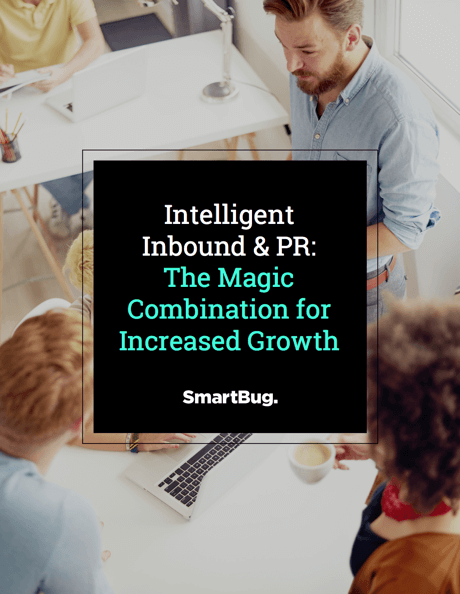.png?width=1800&height=689&name=Hero%20(1).png)
Intelligent Inbound & PR: The Magic Combination for Increased Growth
The coordination of Intelligent Inbound and strategic PR efforts will lead to more visibility, more credibility, more brand recognition, and more potential to reach the target audience. This guide shows you how the two can work together to achieve awesome results.
Download a PDF version of this guide by filling out this form, or keep scrolling to learn more.

Chapters
Overview of Intelligent Inbound and Public Relations
The Magic Combination
How It’s Done: Pass it On
How It’s Done: Tweak It
How It’s Done: Become an Expert
Conclusion
Overview of Intelligent Inbound and Public Relations

Understanding the principles and nuances of both Inbound Marketing and Public Relations is the key to realizing why they work better together. Inbound Marketing is the practice of creating content that attracts prospective customers at any stage of the buying process. It uses content that is helpful, addressing the needs and/or solving the problems of the ideal customer. The content is often dynamic, using a variety of styles and channels such as blogs, social media posts, e-books, infographics, online videos, white papers, and podcasts. The goal of Inbound Marketing is to use this content to attract and engage the most suitable prospects.
So, you probably already knew all of that. But what makes Intelligent Inbound...well, intelligent? It’s using data to eliminate guesswork and make smarter decisions. Intelligent Inbound involves a collaboration of a variety of marketing tools such as:
- Inbound Marketing
- Traditional Digital Content Development
- Paid Search Optimization
- Social Media Outreach
- Branding
It’s about using as many marketing tactics as possible in addition to and on top of regular inbound efforts. To do this effectively, it’s essential to use data not only to understand your target

In terms of business, the traditional purpose of public relations is to manage the flow of information between an organization and society in order to shape and control public perception. This involves the art of engaging, influencing, and building relationships with key players who shape public opinion. But with the confluence of marketing and technology across a fast-changing digital landscape, the value of PR has become so much more.
The practice of PR is easily adaptable. PR pros keep up with trends and know how to get your brand, messaging, and content in front of the right audience. Today, the most successful PR campaigns aim to accomplish a trifecta:
- Enhance Visibility—put your message, brand, and experts in front of a bigger audience.
- Build Credibility—earn validation when third-party outlets look to you as a source.
- Promote Thought Leadership—gain recognition as a key expert in your space.
Capitalize on these valuable goals by combining an effective PR campaign with your Intelligent Inbound Marketing campaign.
Now that we understand what each discipline can accomplish on its own, let’s discuss the magic that happens when we combine forces.
The Magic Combination

When implemented correctly, combining Intelligent Inbound with PR can result in one big happy marriage. Why? Because they both have similarities that complement each other and differences that complete each other. Let’s dig a little deeper:
Similarities
We Go Together
The primary similarity between PR and Inbound Marketing is that they both create a variety of content and messaging that supports brand building and corporate growth. Intelligent Inbound involves building a digital content–
Differences
You Complete Me
Although both Inbound and PR are content creators, their content is different in type and delivery. And even though the type of content they produce can sometimes seem similar, the way that content is distributed can have a huge impact on its effectiveness. For example, Inbound Marketing may create articles to post on social media outlets like LinkedIn Pulse or on their corporate website’s blog. But the audience for those articles is limited, either to current customers and prospects already in the sales channel or to those who frequent those outlets. PR, on the other hand, develops content such as byline articles for publication in third-party media outlets. This puts the message in front of a whole new set of prospects. Disseminating content to the public through third-party media outlets not only increases the size of the audience, it also helps to validate a brand or establish a company as a thought leader in its industry. This is where PR fills in some very important gaps and “completes” an Inbound Marketing program.
So, PR and Inbound make a happy marriage. Can’t they survive without each other? Sure. But why sell yourself short? If you only use Inbound Marketing to create great content for social media and a website, but you don’t get it in front of writers and editors, your content won’t get the visibility it needs to make your message get to where it needs to go. PR gives it the wings it needs to soar.
Likewise, PR can be difficult if you don’t have great—already created—content to break the ice with reporters. It is also evidence of the organization’s expertise. For example, if a thought leader has an extensive arsenal of articles on a particular topic already on their website or in their blog, it helps their PR rep to demonstrate expertise when pitching to the media. If an expert has written a book on a specific topic, this arms their PR rep with the ability to leverage their industry prowess.
So, you see, PR and Inbound really do complete each other. Now let’s explore how to move past the theoretical and put the hybrid approach of using both methodologies into practice.
How It’s Done: Pass it On

The first step in creating the magic between Intelligent Inbound and PR is for each discipline to use the other’s content to their advantage. PR can leverage content already created by marketers and get it in front of third-party outlets. Inbound Marketing can use already published PR content to repurpose for social media, websites, and e-books.
First, let’s take a look at how inbound content can boost PR efforts. Having access to an arsenal of great content helps PR reps make introductions and build relationships with reporters, editors, and bloggers. Those are the people who have the ability to get that material out to the public.
These are some examples of how this can happen:
- Getting your existing infographic or video included in a published article
- Using existing content to position your executives as experts for interviews
- Having your existing article republished on a third-party blog
Why is this important? Because having your material included in outside outlets exposes your company and its brand to a wide-ranging set of new prospects. PR pros work with a variety of different outlets—from local, regional and national news outlets to trade publications that reach vertical audiences. Most of these publications have anywhere from tens of thousands to millions of readers. That’s a lot of extra eyes on you. Taking the audience of an external outlet and adding it to your own readership puts your message in front of more eyes, creates the potential for more views and link referrals, and generates new contacts.
It’s also about brand recognition. Including your infographic or a link to your material in an article—or better yet, having one of your C-level executives quoted in one—also gives credibility to your company and its products or services. It begins to establish you as a leader and an expert in your space. Which means prospects will turn to you for advice, leading them straight into the
.png?width=1362&name=Supporting1%20(1).png)
Now let’s talk about how inbound marketers can use existing PR content to their advantage. PR reps are always working to drum up a steady beat of news, and just because these news articles don’t typically include backlinks doesn’t mean that you can’t use them to generate traffic.
These are some examples of ways marketers can use already-published PR content:
- Post PR articles on your website’s newsroom
- Share articles on social media—use hashtags and links, and mention the news outlet
- Write a blog post related to a published PR article and link to it in the post
By using the methods listed above, marketers are able to repost content that wouldn’t typically include traffic-generating links or CTAs; then post it in a format and on a channel that can drive leads.
That’s not the only way to leverage your existing content. Time to get creative…
How It’s Done: Tweak It

When your Intelligent Inbound Marketing efforts give rise to
Taking it a step further, PR pros can rework your material to create something along the same vein, but altogether different. Then they will pitch it to editorial directors, suggesting the material for a new article called a byline. If accepted, your PR rep will work with one of your executives to craft a new article that is published as an expert piece. Credit for the article is given to your
Byline articles are a great
.png?width=1362&name=Supporting1%20(2).png)
Inbound marketers can repurpose PR content, too. Many times, PR reps have generated thought leadership articles after conducting one-on-one interviews with members of the executive suite—a luxury that isn’t always afforded to marketers. Rather than starting from scratch, marketers can repurpose pieces from thought leadership articles to create rich content. This can come in the form of culling expert commentary from a published PR piece to create social media posts, repurposing the content from a published article into an infographic or Slideshare, or using the structured content of PR pieces to lay the foundation for e-books and white papers.
This allows inbound marketers to use PR content, which is usually devoid of backlinks, to create collateral that will point back to a website or spur dialogue with new contacts. PR reps usually have a close relationship with the C-suite and will create expert pieces that inbound marketers can use in a multitude of ways to drive traffic and leads. Inbound marketers and PR reps alike have tons of content at their disposal. Why reinvent the wheel when you already have so much to work with?
But don’t stop there. Time to leverage that expertise….
How It’s Done: Become an Expert

Once your executives are out of the box by landing interviews and publishing byline articles, they have officially reached

Keep Building Relationships With the Media
Every time your executive is interviewed, he or she is building key relationships with reporters, becoming a trusted source for more material and thought leadership. The next time that reporter is covering your space, you are now the go-to expert for quotes, opinions, and a chance to shape the direction of their latest article. Your PR rep will ensure you stay in front of them and stay relevant.

Show Off the Depth of Your Expertise
As the geniuses behind your products and services, your industry experts are already innovators and thought leaders who know their business inside and out. Now it’s time to tell the world. If they’ve written any books, e-books, blog articles, white papers, or bylines, let your PR rep show them off. This authored content is your expert’s brand. Sell it, show it off. Give everyone proof that your expert truly is one of the top thought leaders in the industry. By putting your executives on the map as
Inbound marketers can also take advantage of an exec’s new expert status by launching recurring campaigns like a blog or web series that point back to published PR content. Leverage social media channels to provide experts another channel for them to share their message.
Conclusion

As you can see, you can enjoy many benefits from creating a happy marriage between Intelligent Inbound and PR. From enhancing visibility to building credibility and leveraging thought leadership, it’s a magical combination.
Use These Six Tips to Get Your Inbound and PR Marriage Off to a Good Start:
- Pitch existing content to reporters at third-party news outlets. They may repurpose, republish, or quote some of it in an upcoming article;
- Share published PR content on your brand’s social media sites or your corporate website;
- Take existing content such as a blog and create a pitch for a new byline article in a trade magazine or online outlet;
- Use executive thought leadership pieces to spur ideas for infographics,
s lideshares , and blog series; - Take existing digital content, such as an infographic or a video, and show it to a writer who may be doing an article on a similar topic. They may even use it in their article;
- Take a book, written by one of your expert thought leaders, and pitch it to an editor or an analyst for a review. The book or excerpts from it may be quoted in an article.
Download this Guide
Simply fill out this form to receive a PDF version of our guide.




